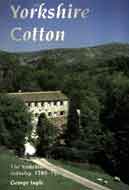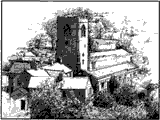| |

About Social Bookmarking



|
|
Malham
Mill
There is little to see at the
site of the old Malham mill, just north of the village on the way to the cove, below the waterfall called originally called Pan Holes and now more often called Mill Foss. The first Ordnance Survey maps
shows that this mill was derelict by around 1850.
The cotton mill was built on
the site of the manorial corn mill, which at the beginning of the 13th century belonged to John Aleman and was given by him to Fountains Abbey. The rent of about 2s per year, was to be used for the relief of the poor who gathered at the Abbey gate. It was later listed in the 1672 Hearth
Tax as being run by Edmond Thompson and Richard Wharfe and continued in use as a corn mill until the late 18th century, John Thwaite was miller in the 1740s.
About 1780 David Kaye wrote to Thomas Lister informing him that Prestons intended to build a cotton mill on the site of the old corn mill at Malham. The new mill
constructed to take advantage of the cotton boom in the 18th century, which was reliant on water power, was a typical Arkwright design of four storeys, measuring 69 x 27 feet,
which could have housed up to 1000 spindles. It was built in 1785
by Richard Brayshaw (Excise officer), Robert Hartley (draper). Robert
Moon (wool stapler) and William Hartley (shalloon manufacturer). Nothing
now remains of the mill except some foundations containing a bridge-like arch on the stream just above the village. There are no known contemporary images of this mill except for this watercolour painted in 1810 by JW Turner, but this shows
only the dam located above the Mill Foss and the sluice for the mill.

Malham Cove - JMW Turner 1810 © Trustees of the British Museum 
When William Atkinson tried to revive the fortunes of the mill and expand it in 1822 he received an extremely negative
response from Lord Ribblesdale who obviously had strong views about the cotton industry. His reply via his agent was recorded in the Kirkby Malham Parish
Report:
Gisburn, April, 1822.
Dear Sir,—My Lord Ribblesdale and the Hon'ble Thomas Lister are
averse to the Establishment of a Cotton Mill at Malham . .. Altho'
it is Possible, if a flourishing trade should take place, a transitory
Emolument might be derived from it, yet in the end it would prove
a Heavy Incumbrance upon the Landed Interest by the Introduction of
a needy population, and a total Change in the Innocent Habits and
Morals of the present Generation. The daily school would be deserted
for the cotton mill. The Boys and Girls in very early life abandoned
to Promiscuous Intercourse, their Minds depraved and their Bodies
by excessive labour and intense Heat so much debilitated and emaciated
that few arrive at the Age of Maturity. For this Sacrifice of Human
Beings the Cotton Maker may become rich, but should he fail it is
needless to point out the dreadful State of the Children and the Landowner.—Malham
is now a peaceful, contented and happy village. If this Cotton Mill
is enlarged and re-established, in a few years the town will be full
of Misery, Vice and Debauchery.—These are the sentiments of My
Lord and Mr Lister. I hope they will be in union with those of the
Freeholders of Malham. His Lordship has ever been Anxious to promote
their Wishes upon all Occasions. Yet he cannot conceal his fears and
apprehension that the Evils above stated will inevitably be the consequence.
His Lordship can give no Countenance whatever to the Mill's Extension,
thinking that its present Capacity is large enough to produce too
many of the Calamities which other parts of the Kingdom have so fatally
experienced.
I am, Dear Sir, Most Respectfully, Yours
M. KNOWLES

Map showing location of mill site
The mill suffered mixed fortunes and cotton spinning there had finally ceased by 1840.
Part of the derelict mill was then used as a house until the latter part of the 19th century, when it was demolished and much of the stone reused to build Ploughley's Barn in Malham West.
|
 |
The site of Malham mill today - only the foundations remain |
Read more about the Processes and Jobs which would be carried out in the Malhamdale cotton spinning mills.
The following
details of Malham mill are from the book Yorkshire
Cotton by George Ingle:
Malham Mill, which was very near Malham Cove, had been
converted from a corn mill in 1785 by a partnership consisting of:
Richard Brayshaw, excise officer, Liverpool
Robert Hartley, draper, Colne
Robert Moon, wool stapler, Colne
William Hartley, shalloon manufacturer, Colne
Brayshaw had recently bought the corn mill and owned other land and
cottages in the area. The partners agreed to pay £50 each towards
the cost of building the new mill. In 1786 the four partners insured
the mill for £300 and their utensils for £200. Unfortunately
the partners had a disagreement so it was decided to partition the
mill in 1796 with part to be taken by Richard and John Brayshaw who
had:
6 spinning frames x 60 spindles = 360 spindles
2 spinning frames x 48 spindles = 96 spindles
and the other part to be taken by Robert Hartley who had:
2 spinning frames x 60 spindles = 120 spindles
2 spinning frames x 48 spindles = 96 spindles
It was Robert Hartley who had wanted to split the mill and Peter Garforth of
Skipton and William Marriott of Marsden in Lancashire had been called
in to decide how the mill should be divided. Internal walls were to
be built and agreement had to be reached on the speed of the front
rollers on the spinning frames relative to the speed of the water
wheel. The rollers were one inch in diameter and would have to run
at a speed of between fifty and seventy revolutions per minute. The
former partners also had to agree not to interfere with the shafting
in the mill or change the quantity or speed of the machines.
Hartley was bankrupt in 1800 and his third part of Malham Mill was
for sale together with his machinery. The complete mill was four storeys
high and measured twenty-seven feet by twenty one feet with an eighteen
foot fall of water to the wheel. The newspaper advertisement mentioned
that the mill was only five miles from the Leeds and Liverpool canal
and that 'from the village of Malham hands may be engaged on reasonable
terms'. The auction was to take place at the Angel Inn, Colne.
Richard Brayshaw leased his section of the mill to William Cockshott
about 1797 and in 18I5 it was leased again to the Cockshott brothers
with part being taken by John & Joseph Lister from Haworth who
were cotton twist spinners, possibly at Griffe Mill near Stanbury.
In I8I5 the mill and contents were insured for £2,400 and cotton
spinning continued until the 1840s. By 1850 the mill was in ruins
and was said 'by no means adds to the beauty of the scene'. The mill
was then pulled down and the stone used to build a barn.
 Click image for more details
Click image for more details |
Copies are available direct from the author,
, at the discounted price of £9.95 including UK P&P
|
|
| Malham, Mallam, Malum, Maulm, Mawm, Malam, Mallum, Moor, Moore, More, Kirkby, Kirby, Mallamdale, Mallumdale, Malhamdale, Malham-Dale, Kirkby-in-Malham-Dale, Kirkby-Malham-Dale, Kirby-in-Malham-Dale, Kirby-Malham-Dale, Hanlith, Hanlyth, Scosthrop, Scosthorpe, Skosthrop, Airton, Ayrton, Airtown, Calton, Carlton, Craven, Yorkshire, Otterburn, Otter Burn, Bellbusk, Bell Busk, Conistone, Family, Genealogy, Geneology, Buildings, People, Maps, Census, Scawthorpe, Scothorpe, |

Cold, Coniston Cold, Bordley, Bordly, Boardly, Boardley, Winterburn, Winter Burn, History, Local, ancestors, ancestry, Scorthorp, Wills, Tax, Eshton, Asheton |
KirkbyMalham.info is not responsible for the content of external internet sites. External links are generally indicated by the  symbol. symbol.
|
|
|






